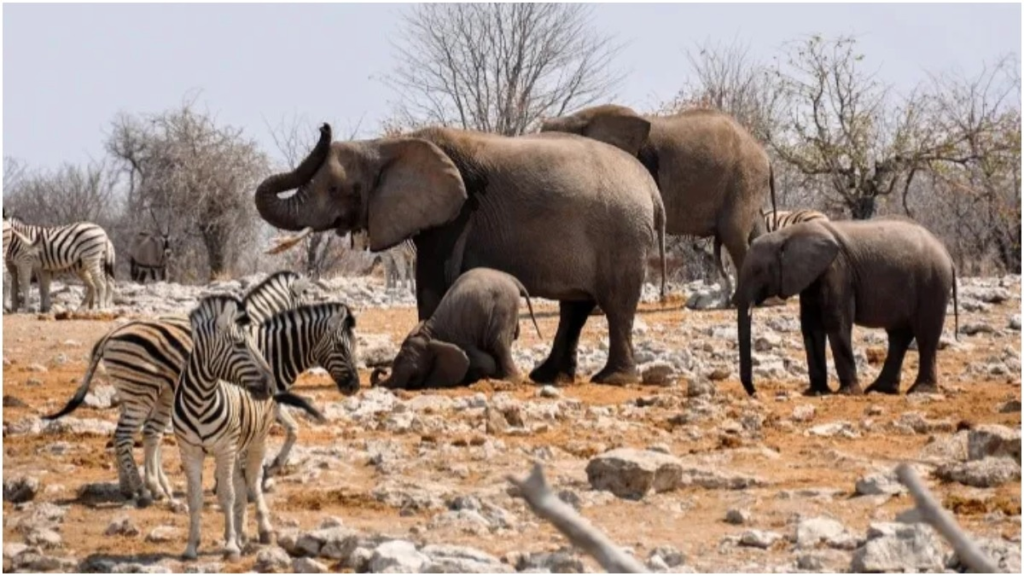Namibia, an African country known for its rich wildlife and landscape, is facing the worst drought in a century. The drought has destroyed about 84 percent of the country’s food reserves, leaving about half of Namibia’s 2.5 million population facing a severe food crisis. To deal with this unprecedented crisis, the Namibian government has turned to its natural resources, especially wildlife. The government there plans to kill more than 700 wild animals, including dozens of elephants and hippos, to provide meat to its people.
A total of 723 animals, including 30 hippos, 60 buffaloes, 50 impalas, 100 blue wildebeests, 300 zebras, 83 elephants and 100 elands (a type of deer) are on the list of animals to be killed. More than 150 animals have already been killed, with about 63 tonnes of meat sent to drought-affected areas. Namibia’s Ministry of Forests, Environment and Tourism said in a statement on August 26, “In this situation, it is necessary for us to take this step and is in accordance with our constitution. Our natural resources are used for the benefit of Namibian citizens.”
What is the reason for drought in Namibia?
Namibia is located in drought-prone Southern Africa, and often witnesses such natural disasters. It declared a national emergency due to severe drought in 2013, 2016 and 2019. The New York Times quoted Julian Zedler, director of the World Wildlife Fund in Namibia, in its report that this time the drought is nationwide and devastating. According to a report by the European Commission, the drought began in Botswana in October 2023 and soon Angola, Zambia, Zimbabwe and Namibia also came under its grip. Currently, most parts of Southern Africa are affected by drought.
The situation in the region is worsened mainly due to El Niño, a weather pattern associated with extreme heat and dry weather in the world and especially in the oceanic parts. After about seven years, El Niño returned to the region in 2023, causing above-average temperatures and very little rainfall across the region. This caused the soil to lose moisture and trees and vegetation to dry up. Apart from this, many studies have shown that the earth’s temperature is increasing due to climate change, resulting in frequent natural disasters like drought and floods in many parts of the world.
How widespread are droughts impacting Namibia?
Food availability is usually low in Namibia from July to September, and the drought has made the situation even worse. Giving information about the situation there on August 23, a UN spokesperson said, ‘Drought in Namibia has destroyed main crops like maize. A large number of cattle have died due to water and food crisis. There is a serious food shortage in the country. As stocks have decreased, prices have skyrocketed, reducing access to food for a large number of people.’
According to the Integrated Food Security Phase Classification (IPC) report, ‘Between April and June this year, an estimated 1.2 million people in Namibia (about half the country’s population) faced a severe food crisis.’ The United Nations Office for the Coordination of Humanitarian Affairs said in a report that the problem of malnutrition among children under the age of five has become serious and deaths have also occurred in some areas. Namibia’s economy depends heavily on agriculture and livestock. Both these sectors are suffering huge losses due to lack of rain.
How will Namibia deal with drought by killing animals?
The Namibian government has decided to kill the animals not just to satisfy people’s hunger with their meat. Rather, the government fears that due to drought, animals are also forced to migrate in search of food and water. There is a danger of them coming out of the forests and coming towards residential areas, which can lead to conflict with the human population. The country has a large number of wild animals, including 24,000 elephants. Namibia is one of the countries with the largest wildlife population in the world.
A statement from Namibia’s Ministry of Forests, Environment and Tourism said, ‘We hope that killing some animals will reduce the impact of drought on wildlife. We think that in forest areas where the number of animals is more than the food and water available for them, killing some animals will help manage the availability of food and water. Animals whose hunting is not prohibited in Namibia also include zebra, blue wildebeest and impala. People in southern African countries usually use the meat of these animals as food.
Source (PTI) (NDTV) (HINDUSTANTIMES)
